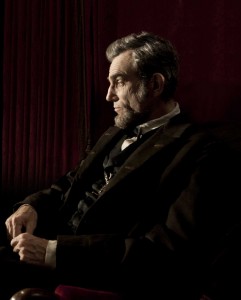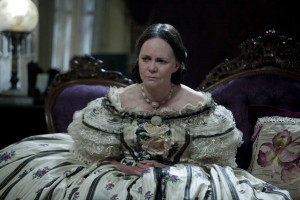
Joanna Johnston, costume designer on director Steven Spielberg’s Lincoln, had only a few months to research and prep for the film. She started the hard work in July 2011 and the shoot began the following November. However the film had been on Spielberg’s to-do list for nearly a decade and she had been asked several times to come up with a preliminary budget. “That long build-up process helped me think out my strategy,” she said.
Johnston, who has worked on five previous films with the director going back to Indiana Jones and the Last Crusade in 1989, found there wasn’t much available from the world of costume houses that was quite right, “because when Hollywood got into its rhythm in the 1930s and 1940s, clothes were heavily tailored in historical pictures, including most recreations of the Civil War era. But what men really wore in the 1860s was not heavily tailored at all.”
And the cast is overwhelming male in the movie, with Abraham Lincoln, the 16th president – brilliantly portrayed by Daniel Day-Lewis – at the center. A few outfits from the period were found in “a worldwide gather.” Key was coming upon some of Lincoln’s original clothing stored in the Smithsonian Museum in Washington, D.C.
A trove of period photographs was her fallback. Photography had just been introduced in the mid-19th century and it quickly gathered momentum across all strata of the population. “Everyone was getting their picture taken, so that was my main resource, because so much information was contained in those photos. Lincoln himself realized the power of the photograph and was extensively photographed by Matthew Brady,” observed Johnston.

A big challenge was to differentiate the men’s apparel within the narrow confines of style and fashion of the period. That was especially required in the crowded scenes in the House of Representatives where over 100 characters were crowded closely together debating whether to pass a constitutional amendment to abolish slavery. “I did a lot of small moves to create nuances,” she said. Most of the legislators wore frock coats, or variations, but they had different shirts, and different ties. “And when you study men of that period, there were a million ways they tied their ties.” Johnston had cloth died many gradations of off-black for variety, as well as dark browns and greens. Different cloth textures were also utilized.
Day-Lewis’ outfits were more than just unstructured. His clothes were also designed to be a bit loose fitting, mirroring Lincoln’s gangly appearance in how he dressed as reflected in Brady’s photos, along with a slight feeling of discomfort in what he wore. The costume designer excelled in recreating Lincoln’s iconic silhouette. Another masterful touch was the shawl she made for the actor. “Daniel wrapped himself in it in so many ways, using it to reflect his moods and thoughts, depending on the way he wore it. It was absolutely brilliant,” said Johnston.
There are only three female characters in the film, most notably Mary Todd Lincoln, the president’s wife, played by Sally Field. To expedite her research Johnston sought out Catherine Clinton, author of Mrs. Lincoln: A Wife, considered to be the definitive biography of the first lady. “She told me about her as a woman, how she was a bit of a peacock, interested in clothes and keeping up with fashion,” said the costume designer.
Johnston meticulously recreated one of her outfits from the Chicago History Museum. Another dress she wears in the emotional confrontation with her son Todd about his enlistment was the merger of two dresses’ “essence, and not a true copy,” she noted. It’s a cream-colored silk gown with green and purple print trimmed with lace.

The costume designer also played up the volume of Mrs. Lincoln’s dresses, making her a dominating presence on screen. “The use of crinoline to balloon out dresses was at its historical peak in 1865,” she said. Each of the dresses took up to 12 days to fabricate and Field came in for daily fittings.
Being quite slender, Field was asked to gain quite a bit of weight for Lincoln, as much to fill out her face as her waistline, so she would look more like the historic Mrs. Lincoln. “Sally was quite accommodating,” Johnston recalled. “She started four months out, went to nutritionists and added 20-25 pounds. But when she came to fittings she was often furious because of the horrible food she had to eat.”
Johnston has also designed costumes for Spielberg’s Saving Private Ryan, War of the Worlds, Munich and War Horse. She worked with director Robert Zemeckis on numerous films including Who Framed Roger Rabbit, Back to the Future II and III, Forrest Gump, Polar Express and Cast Away. Johnston recently received a Critics’ Choice nomination for best costume design for Lincoln.





